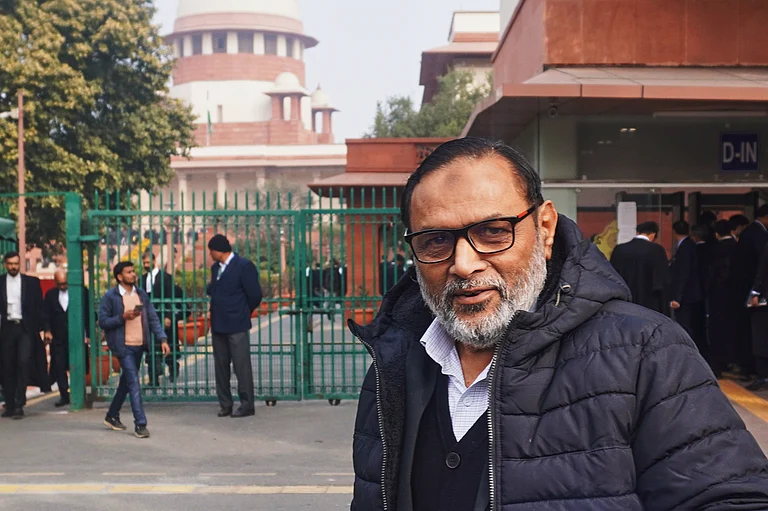In the weeks leading to Diwali every year, civic workers in Mumbai would go on strike. They would stop all the work of the municipal corporation and demand festive bonuses, better pay and more amenities. It had become a tradition of sorts. This year, however, there is no strike. Various amendments to labour laws brought in by the Central and state governments have made workers fearful of losing their jobs and thus reluctant to take part in activism, claim trade unionists.
“Privatisation is the need of the hour,” says a bureaucrat in the Maharashtra government. “But workers’ unions oppose privatisation. Labour laws needed a relook.”
A 2016 paper, “Is Labour Law a Hinderance in India’s Public Enterprises Reform”, by economist Nalin Bharti and senior bureaucrat and former member secretary of the Disinvestment Commission Gopal Ganesh, claimed that even as India initiated major private participation in ownership of public enterprises, the country’s laws lagged. “Indian labour law is helpless in helping the labour and in protecting the larger interest of the PE’s (public enterprise) reforms,” said the paper.
Since being first elected in 2014, Prime Minister Narendra Modi’s government has set ambitious disinvestment targets. In its first fiscal year (2014–15), the government had set a disinvestment target of Rs 58,425 crore. In the last fiscal year (2021–22), it had a massive target of Rs 1.75 lakh crore, which was revised down to Rs 78,000 crore. For this fiscal year (2022–23), the disinvestment target is a modest Rs 65,000 crore.
Several experts claim that the government had not met its targets because of opposition from trade unions. “The mindset of the worker needs to change and trade unions are not helping with their archaic thinking,” says the senior Maharashtra bureaucrat.
To ease labour laws and encourage private investment in the economy as well as disinvestment, the Indian government in 2020 passed three new laws—Industrial Relations Code, 2020, Code on Social Security Bill, 2020, and Occupational Safety, Health and Working Conditions Code, 2020. These laws have made it easier for employers to lay off workers. Earlier, firms with up to 100 workers could hire and fire without government permission; now the threshold has been increased to 300 workers.
Striking has also become more difficult. Flash strikes have been banned and workers in industrial units now must give a 60-day notice before going on strike. “Trade unions are dying,” says the office bearer of one union in Mumbai. “We will soon have to shut down our offices.”
Glorious past, uncertain future
This is a far cry from the legendary strikes in the textile mills of Bombay (Mumbai) led by trade union leader Datta Samant that began in 1982. (Technically, it continues to this day because it was never called off.) Thousands of workers stopped production at the mills, demanding better housing, higher wages, job security and reduced working hours. In the years that followed, the mill owners shut down their units, leading to massive job losses.
Workers now, however, are uneasy about joining unions as they fear they will lose their jobs, says Praveen Ghag, president of the Girni Kamgar Sangharsh Samiti, a trade union. “There is so much job insecurity among workers,” he adds. “The laws have put investments and employers’ rights over the rights of the workers. The welfare of employees is very low in the priority lists of mill owners. There is not much trade unions can do. So, workers are not seeking help from unions or forming any new ones.”
Various issues that unions earlier took up—working hours, amenities for workers, rest hours, and wages—have returned in full force, says Ghag. “We are back to where the labour force was in the 1960s and 1970s,” he adds. “The future without the trade unions will spell doom for the workforce in India.”
Post-pandemic landscape
The effect of the Covid-19 pandemic on the economy has led to major changes in the labour market, says Ghag. Employers and owners of manufacturing units are increasingly providing only contractual jobs and permanent employment is fast disappearing.
In January 2020, the Central Trade Union Organisations held a nationwide strike to protest the labour laws. They had also raised objections against the widespread disinvestment of public sector enterprises and privatisation, including the government plan to allow 100 per cent foreign direct investment in the retail sector. However, this does not seem to have had much effect.
The heyday of trade unionism in the country was before 1991, when the Indian government, confronted with an existential balance of payments crisis, decided to open its planned economy to foreign investment. While Liberalisation, as it came to be known, was a boon to the upper and middle class, significantly increasing industrial production, job opportunities and earnings for them, the proletariat suffered.

“After 1991, the importance of the labour unions was reduced,” says Asmita Dange, who has researched the evolving trade markets in India. “Now, they have been almost wiped out. The State Labour Advisory Board, which was an important member in the tripartite forum of negotiations (between employers, workers and the government), is not active at all.”
Coalition politics, which became the mainstay of the Indian political landscape from the 1990s, also led to the neglect of workers’ rights, says Dange. Andhra Pradesh, Gujarat, Maharashtra, Karnataka, Rajasthan, Haryana, Madhya Pradesh and Uttar Pradesh have amended the labour laws. “Many states have made drastic changes to the labour laws in a bid to attract investment,” adds Dange. “Workers are now often working for 12 hours or more. With workers not participating in union activities, there is little they can do.”
In 2020, Uttar Pradesh promulgated an ordinance that suspended the operations of all labour laws applicable to factories and manu-
facturing establishments in the state for three years. No new trade union can be registered for this period. Employers can hire casual workers for any kind of work and need not provide them with even the basic amenities “This can be extended after three years and become permanent,” says Siddhesh Marathe, another researcher of the India’s labour laws.
New ideas for new times
New ideas have also been introduced in the country’s labour laws. This includes the concept of a ‘negotiating union’ or a ‘negotiating council’. According to the new codes, each company will now have only one union, which will be recognised. If the union fails to enlist 51 per cent of the workers, the employer can form a negotiating council.
Union leaders say most employers do not see the need for any dialogue with trade unions. “We represent workers and if we are kept aside, the rights of the workers are compromised. This is happening right now,” says Rajan Tikey, a union leader.
Rights such as working hours and wages are also being diluted, say trade unionists. Many state governments have either amended or are planning to change the Factories Act of 1948, to extend the maximum working hours. “There is a huge gap in the wages too,” says union leader Ghag. “Those with short-term contracts get paid less than those with long-term contracts. They are not given paid leaves.”
The Trade Unions (Amendment) Bill, 2019, has also given the government complete control to recognise trade unions. “We have been protesting against this,” says Ghag. “When employees lose jobs easily, they do not enrol with the unions. So, it is not possible to get the required number of members.”
“The future is very bleak for the workforce as there may not be unions to represent them,” says Marathe. Workers and researchers, however, are not convinced by the government’s rhetoric that flexibility in labour laws will bring in more private investment. “There is no proof that the changes in the labour laws have brought in more investments,” says a member of the All India Trade Union Congress.
(This appeared in the print edition as "Uncertain Future")


























